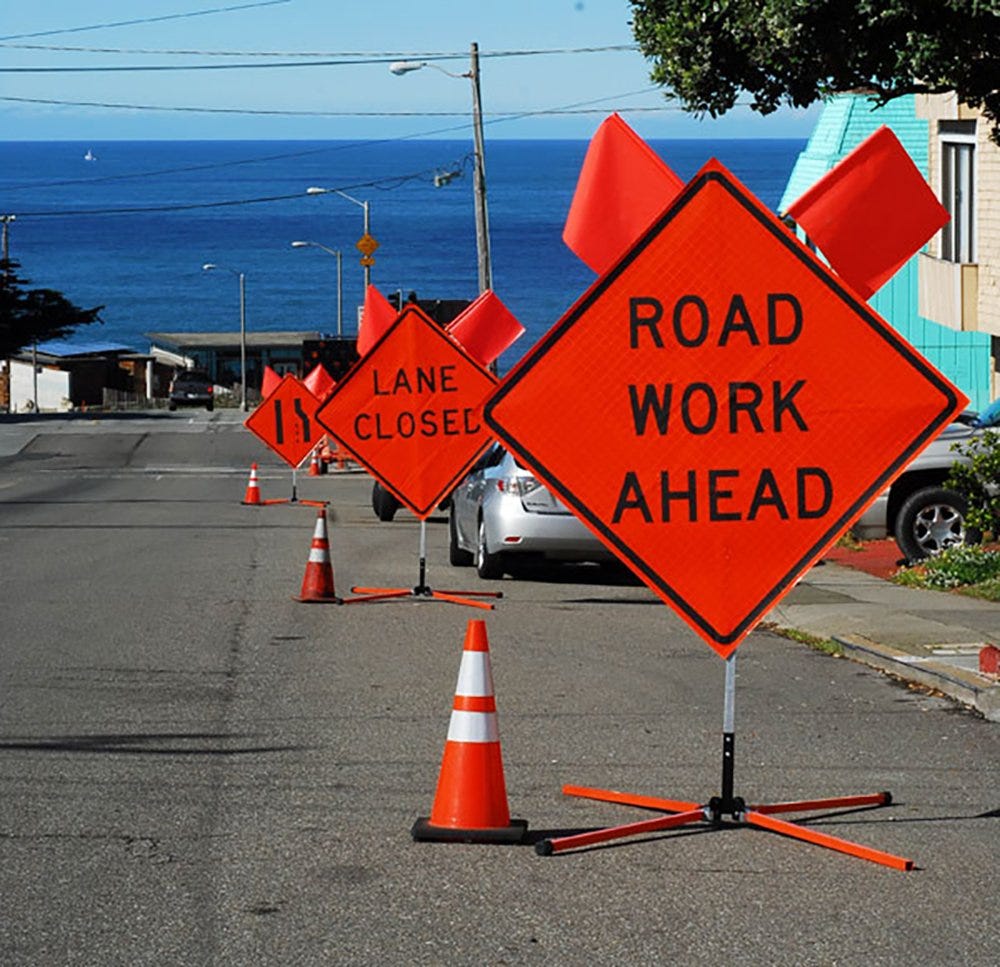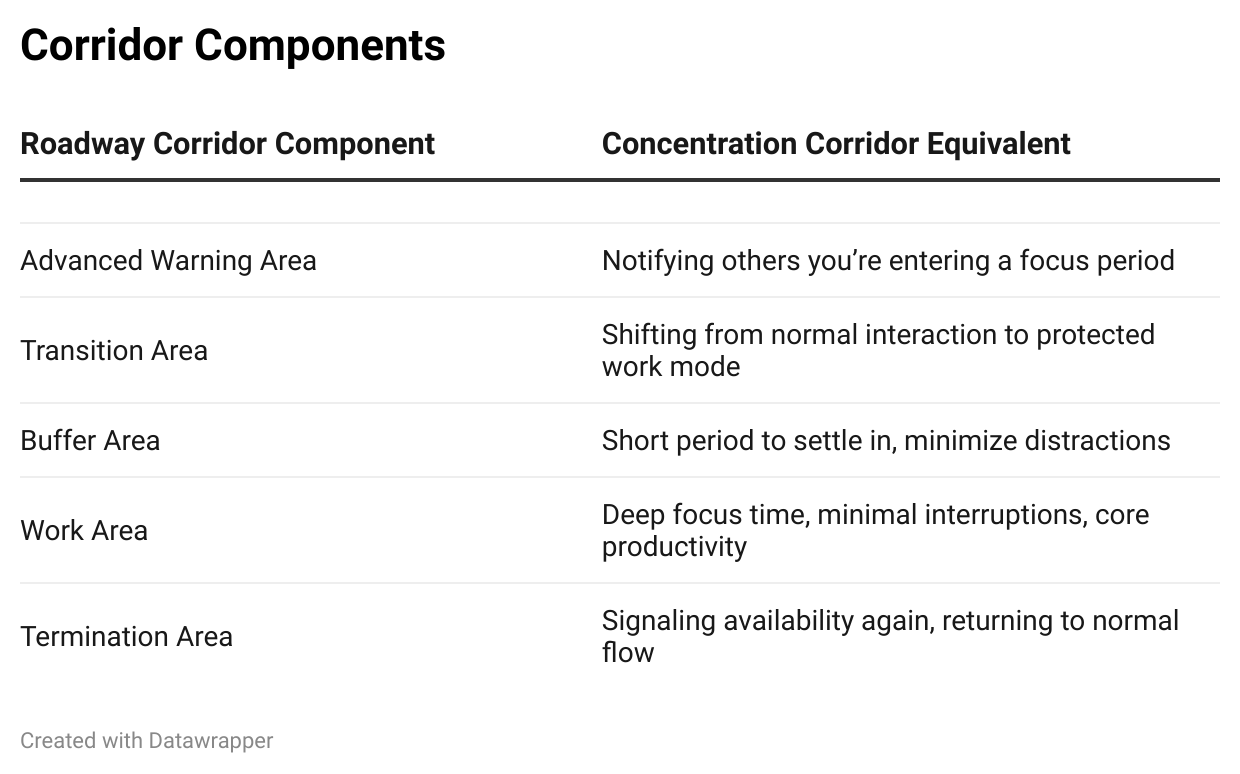Visualize The Load, Spread the Impact
Overload in your mind is often manageable with the eye, build a concentration corridor.
“Have you responded to the jury duty letter yet?” “No.” “You need to do that.” “I know.” “Did you contact the neighbor yet and let them know we would be working on the house?” “No.” “You need to do that.” “Did you….”
Right now, I have a lot going on and it is easy to pick on my wife for nuking my concentration because we have a lot going on. And we are doing the work to maintain the “a lot” in a way that is planned, but while not living in our home, not having a base of operations, and dealing with new surprises several times a day.
We are relying on each other for support, but also driving each other crazy “changing our minds” all the time…which means we are each reacting to constant new stimuli together and individuals. Constantly coming up with new strategies and tactics in our individual heads while trying to keep each other informed and making sure what we’ve already agreed to is happening and forgetting when we’ve changed things, losing track of things, etc.
While trying to concentrate on things, other things are changing, we change our assessment of situation, but we don’t share that because we were concentrating on something else and desperately want to get back to it.
But Wait, There’s More

While those things are going on,
and I are working on creating these posts, building a new business model (or new layer of business model) (or models) on top of the existing work of Modus Institute and Modus Cooperandi. So just add all the stuff with my wife to Modus and the next thing you know, I’m reacting … loudly … when people ask if I’ve done something or if something has happened … and then being reminded that it needs to happen.Today I found myself in an AirBnB on Mercer Island with no post it notes and just a huge sharpie and many boxes of Maybe. Maybe boxes are things we couldn’t figure out if we were going to move with when we got to the move-out deadline and went to visit family. These take the shape of dozens of blue shopping bags filled with the flotsam and jetsam of 20 years of living.
Concentration Corridor Creation
So, I grabbed an old folio from a 1980s Tokyo redevelopment project (flotsam) and created the thing in the image. Let’s call it “ShutUpAndLetMeWorkBan” or … maybe … think of this in a more helpful way. Maybe this is a Concentration Corridor.
Concentration Corridors appeal to the old urban and transportation planner in me. My personal focus and productivity required the same care of design as did construction and safety corridors on highways. This idea could be both practical and powerful.
How Construction and Safety Corridors Work
When major roadwork is done, we establish work zones or safety corridors to protect workers and guide traffic safely through areas of change or hazard.
See where I’m going with this? These corridors are carefully structured and communicated to everyone (drivers, construction workers, oversight, law enforcement, etc.):
Advanced Warning Area: Alerts drivers to upcoming changes and gives them time to adjust.
Transition Area: Guides traffic smoothly into new patterns using signs, cones, and barriers.
Buffer Area: Provides a safety margin between moving traffic and the work zone, reducing risk.
Work Area: The core zone where actual construction or maintenance happens—access is controlled and only essential personnel are allowed.
Termination Area: Signals the end of the work zone and guides traffic back to normal flow.
These visual controls use clear signage, physical barriers, and predictable communication protocols to ensure everyone’s safety and understanding of changing conditions.
Applying the "Concentration Corridor" Concept
When we create a visualization that helps us personally focus and allows us to communicate that focus to others (even if they still interrupt us and ask), we are building our own Concentration Corridors. They are a set of built and visible objects that let us:
Designate protected time and space for deep work, just as highways set aside space for construction.
Set clear boundaries and signals for yourself and others. We can communicate when we are in a focus zone and should not be interrupted, or should be interrupted (welcome collaboration), for specific things. If I’m in a zone where I am ready to work on the landscaping of the house, then I totally want my wife involved. Much like work zones have signs and barriers, they also have the work that is done within the zone.
Allow for flexibility and change: Just as road conditions and work zones can shift due to unexpected discoveries (you wouldn’t believe how many body parts construction crews dig up) or hazards, your concentration needs and boundaries may shift as new tasks or surprises arise. Communicating these changes is part of maintaining the corridor.
Prioritize safety and progress: In roadwork, the corridor ensures both the safety of workers and the flow of traffic. In your life, a Concentration Corridor protects your attention and progress on what matters most, while still allowing for essential communication with those you care about. One step beyond this, the psychological safety of yourself and others is enhanced and protected. Much of our psych safety issues are learned “do not approach” behaviors because we’ve been snapped at, yelled at, or other wise “something at”ed. And we do it to others. Concentration Corridors are a great way to keep people calm, therefore keep them in a humane headspace, therefore maintain psych safety.
Your Concentration Corridor is a Roadway Corridor(ish)
Collaborate Alone and Together
By building and communicating Concentration Corridors, you are creating an immediately accessible view of what you need to do, who you need to work with, and what the information you are learning (the plural you) is that is likely to change and needs to be shared. This puts you in a recurring position where you are:
Gaining control over your tasks and time
Categorizing your work and boundaries clearly
Proactively informing those around you about your shifting needs and focus
Getting their information about shifting needs and focus
Changing what you think collaboration means (think about it)
Creating flexible, adaptive structures that acknowledge conditions will change and that communication is key to maintaining mutual support and understanding
Now, think about every self-help book you’ve ever read. This is the core of what they are all trying to do. Most of them just skip the visible and how-to-share-it parts.
It is clear that with my wife and my colleagues, any information I don’t share or any work scopes I change unilaterally hurts them. I don’t mean for it to, but it happens. They don’t mean to return the favor, but they do. In fact they must.
So if we don’t want to slow work down, stress people out, and frustrate value across the board, creating visual zones where we know what work is being performed, by whom, and what is to be learned, we will be able to quickly, efficiently, and sanely complete work.
And remember, you cannot have efficiency and effectiveness without information and professionalism. Humane work is a core competency.
Need A Little Push? Working with us doesn’t have to be a big deal. Just grab us for a few hours. If you’d like Jim and Toni to review your teams’ visualizations, help build out your Kanban or your Obeya, do a Value Stream Mapping Exercise, or just discuss how you all are working and communicating, just drop us a line. (or just ping me on LinkedIn)





